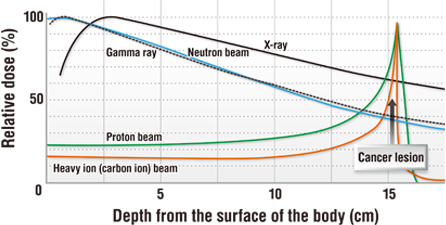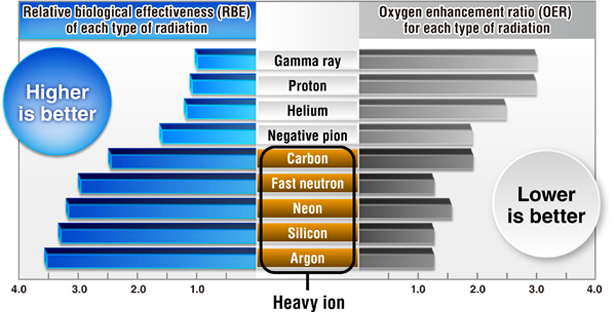
- What is heavy ion radiotherapy?
- Advantages of heavy ion radiotherapy
Advantages of heavy ion radiotherapy
Highly effective on deep and radioresistant cancers
Hope for effectiveness on cancer lesions deep in the body, with little influence on surrounding tissues
Conventional radiotherapy has weaknesses: because the dose is highest just below the surface of the body and gradually decreases with depth, it has less effect on cancers deep in the body, and causes damage to the surrounding normal tissue. If heavy ion beams are used, due to their high physical dose distribution, we can concentrate the high dose to a targeted cancer lesion deep in the body, with little effect on the surrounding normal tissue, by adjusting the dose peak. Also, heavy ion beams have an advantage in cancer therapy in that their relative biological effectiveness (RBE; see below) increases with the depth from the surface of the body, and thus heavy ion radiotherapy is effective against cancers deep in the body.
Dose distribution of each radiation in the body

High cytolethality, and effective on highly radioresistant cancer
There are two indices of the therapeutic effect of radiation: relative biological effectiveness (RBE) and the oxygen enhancement ratio (OER). Compared with the effects of gamma rays, the therapeutic effects of carbon ion (heavy ion) beams are about three times more effective in terms of RBE, and about two times more effective in terms of OER. Also, it cannot be easily subject to the influence of the interstitial oxygen concentration. Thus, heavy ion radiotherapy offers hope for effectiveness on cancers resistant to conventional radiotherapy, such as sarcoma and adenocarcinoma, and locally advanced cancer.

Hypo-fractionation is possible
The RBE of a heavy ion beam becomes higher with the depth from the surface of the body, which makes it possible to finish the therapy in a short time. In this therapy for first-stage non-small-cell lung cancer and hepatocellular carcinoma, treatment in one or two fractions is possible. For cancers that traditionally require a relatively large number of fractions, such as prostate cancer and bone and soft tissue tumors, the estimated fractions are between 16 and 20, and are approximately half as many as those for X-ray and proton radiotherapy. Therefore, patients who undergo heavy ion radiotherapy can maintain their quality of life (QOL), with few burdens on the patients and their families. At present, the average number of fractions (estimated) is approximately 12 (for approximately three weeks).














